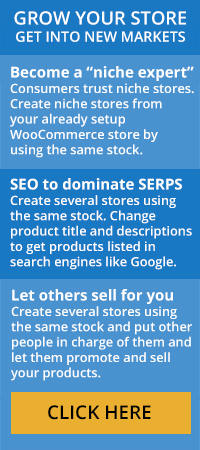Attracting visitors to your WooCommerce store is only part of the e-commerce battle. The real challenge is transforming visitors into customers. While the cornerstone of conversions is product quality, the following 11 tips build upon your quality and catalyze would-be buyers into loyal customers.
Use an Anticipation Design Format
Customers rarely make a purchase decision based on category pages. In the most simplified definition, your ecommerce business has three layers. The landing page is the outer crust. Here, visitors receive bite-sized information designed to answer questions and provoke an action. Category pages form the middle layer, while individual product pages form the core.
Category pages must build upon information presented on the landing page, but without repeating information. Design and content must be precisely engineered to engage visitors and encourage action. Extrapolate upon specific details visitors find most useful and build anticipation via visual and text-based marketing tactics. Above all, anticipate the needs of visitors to satisfy, delight and navigate forward.
Intuitive Product Comparison Feature
Before purchasing, around 81% of online shoppers comparison shop before making a decision. Some of this comparison is done between brands, but if you sell similar products with varying features, customers likely compare each product to determine their best choice. Add a click-to-compare feature directly within your category pages. This satisfies the customer need for information while keeping them within your website.
Conversion-Engineered Category Page Headlines
Category page headlines must clearly identify its contents, while establishing product continuity. Be sure to use the main keyword within the H1 heading tag. Never shorten or use non-branded product descriptors. For example, if you sell different types of aquariums, the category page headline should explicitly state aquarium type, such as: reef aquarium, saltwater aquarium or freshwater aquarium. Use consistent language throughout your site to prevent confusing visitors, which can quickly diminish perceived trustworthiness.
Category Page Description Word Count & Location
Craft a custom description paragraph for every category page. This not only allows search engine crawlers to better understand page contents, but offers a powerful branding opportunity. Keep the on-page description less than 500 words. Brevity is paramount, which means every word must count. Weave long-form keywords and essential information visitors will find useful.
Place this descriptive blurb at the bottom of the category page. You may find adding a sentence at the top helps guide readers, but in terms of user friendliness, best practices suggest nothing other than the headline comes before product tables. Perform A/B testing to determine ideal position based upon your demographic preferences. There are several WooCommerce A/B testing plugins capable of streamlining this important task.
Faceted Product Filter Navigation
Category pages must facilitate swift and intuitive product navigation. Just like visitors demand fast website performance, they equally expect product navigation to be a quick and effortless experience. Facet product filtering allows instant search refinement by clicking filters, such as size, price, color, etc. Faceted navigation supports swift comparisons and boosts conversion rates.
Category Page Banner Optimization
Successful WooCommerce category pages use an image/text banner underneath the page headline. Image banners may advertise a current or upcoming sale, boost new product visibility or assist in storefront branding. Maximize its SEO potential by including alt-text data and using keywords within the actual image text. Use professional photographs, preferably of your store products. Include a call to action (CTA) phrase, such as “Shop Now” or “Hurry, Limited Time Only.”
Simplify Navigation via Breadcrumbs
Should a visitor wish to return to a previous page, but aren’t clear how or where they wish to go, you’ll likely lose a potential customer. Optimizing WooCommerce conversions requires complete dedication to the end-user experience. Breadcrumbs placed at the top of the page clearly display the current location. Moreover, it visually simplifies reverse-navigation. Place breadcrumbs on each category page.
Customized Product Showcase
The initial products displayed within a category page should clearly demonstrate category-specific products. Carefully determine initial product showcase based upon the most popular items within the category. If you’re running a sale or advertising new products, this space offers an enticing glimpse for potential buyers. Rotate products based on buying trends and desirability.
Forget Tags and Leverage Sub-Category Pages
Duplicate content plagues many e-commerce stores. When you add tags into this pile of confusion, it makes matters worse. For example, you have a “Fanny Pack” category page and a “Fanny Pack” tag page. This may make sense to you, but oftentimes confuses Google and adds unnecessary website bulk. The best solution is maximizing sub-category pages rather than tag-based navigation.
Provide Enhanced Descriptions on Demand
Some visitors crave in-depth information, others simply require the basics. How can you satisfy both customers with such conflicting desires? The solution is easier than you may realize. Satisfy those who demand deep-level category page descriptions and those who don’t with a collapse plugin, such as Category Collapser for WooCommerce SEO. By default, content is collapsed, but if a visitor wishes to read more, the entire text is expanded by a click of a button. This tactic boosts SEO potential and maintains user experience for both research-minded and quick-decision customers.
Catalyze Conversions via Video
Did you know landing page conversions can increase by 80% when a video is used as part of its overall design? Since category pages are landing pages for a specific product type, it goes without saying videos can significantly boost overall conversions. Rather than a static product image, use custom created videos to demonstrate and showcase products. Focus on highlighting features while solidifying your brand personality and identity.
Boosting WooCommerce conversions isn’t a one-size-fits-all formula. However, with these tips, and a little creativity, you can optimize not only visitor experience, but also conversion rates.



